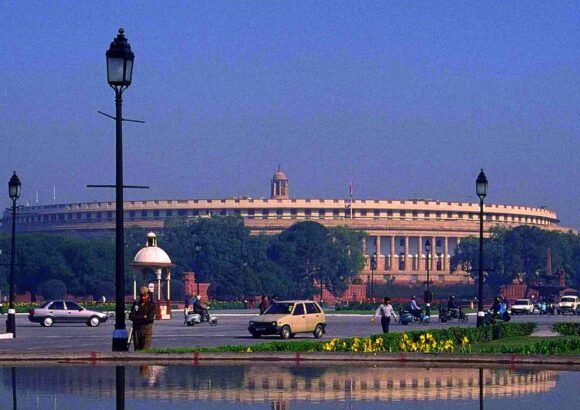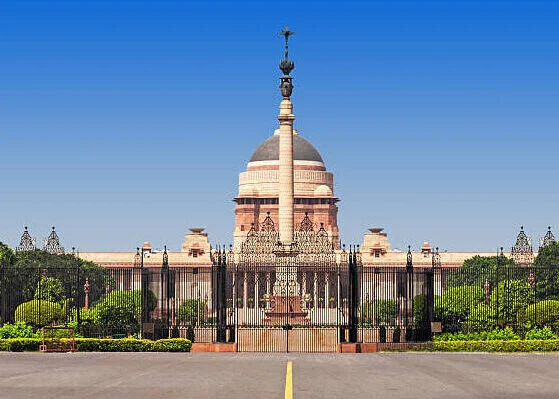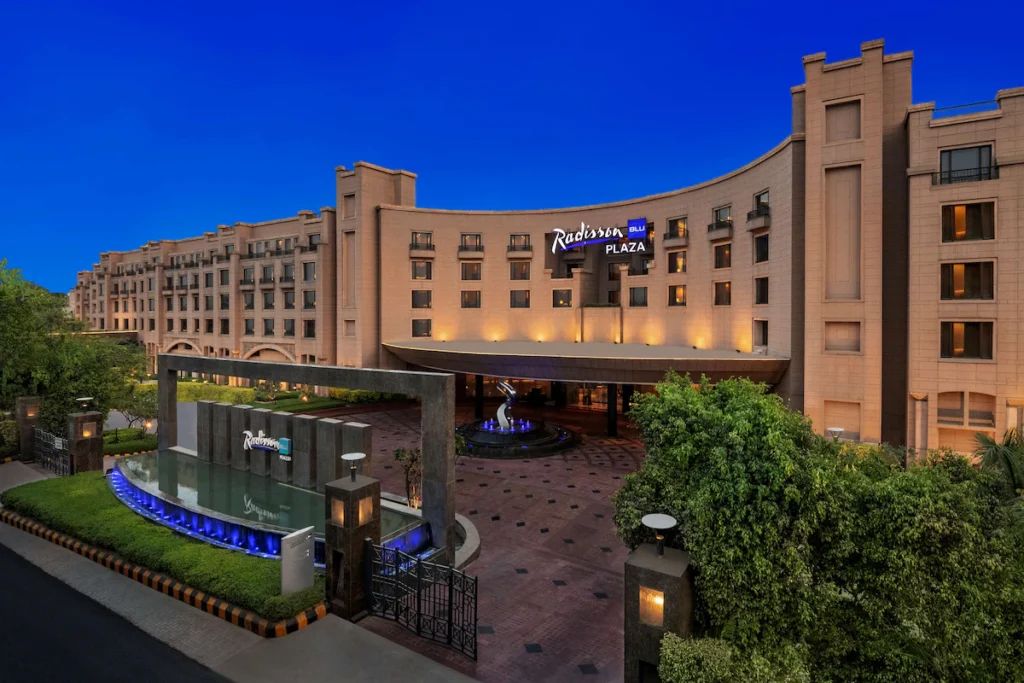Delhi
The Capital City of India






Places To Visit In Delhi
Best Time To Visit Delhi
Winter Season (Oct to Mar)
- Pleasant temperatures (5°C to 25°C) for outdoor activities.
- Clear skies and minimal rainfall.
- Popular attractions like India Gate bustling with tourists.
- Festivals like Diwali and Christmas add cultural vibrancy.
Summer Season (Apr to Jun):
- Warmer temperatures (20°C to 35°C), suitable for outdoors.
- Off-peak period with fewer crowds.
- Ideal for visiting historical monuments and gardens.
- Comfortable weather for outdoor events and festivals.
Monsoon Season (Jul to Sept)
- Hot temperatures (25°C to 45°C) and high humidity.
- Limited outdoor activities due to extreme heat.
- Indoor attractions like museums and shopping malls popular.
- Ideal for evening outings and enjoying indoor experiences
Top Popular Hotels in Delhi
1. Geography and Climate:
- Location: Delhi is located in the northern part of India, bordered by the states of Haryana and Uttar Pradesh. It lies along the banks of the Yamuna River.
- Climate: Delhi experiences a continental climate, with hot summers, mild winters, and a monsoon season.
- Summer (April to June): Temperatures can soar above 40°C (104°F), often reaching up to 45°C (113°F), making it extremely hot and dry.
- Monsoon (July to September): The monsoon brings heavy rainfall and humidity, which can cause flooding and traffic disruptions.
- Winter (November to February): Winters are cooler, with temperatures ranging from 5°C (41°F) to 20°C (68°F), and sometimes even dipping below freezing in December and January. The weather is generally dry and comfortable.
- Best Time to Visit: The best time to visit Delhi is during the winter months (November to February), when the weather is pleasant and ideal for sightseeing.
2. History and Heritage:
- Delhi has been an important city throughout Indian history, with several empires establishing their capitals here, including the Delhi Sultanate and the Mughal Empire.
- It has seen the rise and fall of many dynasties, and each era has left its mark on the city’s architecture and culture.
- Notable historical events, such as the Indian Rebellion of 1857 and the Indian Independence Movement, took place in Delhi, making it a key city in the history of India’s independence.
3. Culture and Diversity:
- Multicultural Society: Delhi is a melting pot of cultures, languages, and religions. People from all over India and the world come to Delhi, creating a diverse and vibrant city.
- Languages: The primary languages spoken are Hindi and Punjabi, while English is widely spoken, especially in government offices and urban areas.
- Festivals: Delhi celebrates a wide range of festivals, including Diwali, Eid, Holi, Dussehra, Christmas, and Baisakhi, among others. These festivals are marked by grand celebrations, processions, and public gatherings.
- Food: Delhi is famous for its street food, such as chaat, paranthas, kebabs, butter chicken, and chole bhature. The city has an extensive variety of cuisine, from North Indian to international flavors, available in both street-side stalls and high-end restaurants.
4. Key Landmarks and Attractions:
- Red Fort: A UNESCO World Heritage Site, this grand fort is an iconic symbol of Mughal architecture and a central landmark in Delhi’s history.
- Qutub Minar: Another UNESCO World Heritage Site, this towering structure is the tallest brick minaret in the world and a significant example of Indo-Islamic Afghan architecture.
- India Gate: A war memorial dedicated to Indian soldiers who died during World War I, offering beautiful views of the surrounding gardens and avenues.
- Humayun’s Tomb: The tomb of Mughal Emperor Humayun, it is considered a precursor to the Taj Mahal and a masterpiece of Mughal architecture.
- Lotus Temple: Known for its unique lotus flower-shaped architecture, this Bahá’í House of Worship is open to people of all faiths.
- Akshardham Temple: A modern temple complex showcasing traditional Hindu art and culture, with a water show and cultural exhibitions.
- Jama Masjid: One of the largest mosques in India, built by the Mughal Emperor Shah Jahan, offering grand views of Old Delhi.
- Raj Ghat: The memorial site of Mahatma Gandhi, where he was cremated after his assassination in 1948.
5. Economy and Industry:
- Political Capital: As the capital of India, Delhi is the hub of Indian politics, home to the Prime Minister’s office, Parliament, and the President’s residence.
- Business and Commerce: Delhi is a major center for commerce, finance, technology, and trade. It hosts numerous national and international companies, with thriving industries in sectors like IT, manufacturing, construction, and retail.
- Tourism: Tourism is a significant contributor to the economy, with visitors coming for business, culture, history, and spirituality.
6. Transportation:
- Delhi Metro: One of the most efficient and rapidly growing metro systems in the world, the Delhi Metro connects almost all parts of the city, making it an essential mode of transport.
- Buses and Rickshaws: Public buses and auto rickshaws are popular forms of transportation, although they can be crowded during peak hours.
- Taxis: Delhi has numerous taxi services, including app-based cabs like Uber and Ola.
- Indira Gandhi International Airport: Delhi’s international airport connects the city to the rest of the world and serves as a major hub for domestic flights.
- Railway Network: Delhi is well-connected to other parts of India via an extensive railway network, with major railway stations like New Delhi Railway Station.
7. Education and Research:
- Delhi is home to some of India’s premier educational institutions, such as the University of Delhi, Indian Institute of Technology (IIT) Delhi, Jamia Millia Islamia, and All India Institute of Medical Sciences (AIIMS).
- The city also hosts a number of research centers, think tanks, and governmental organizations.
8. Challenges:
- Pollution: Delhi faces significant air pollution, especially during the winter months, when fog and smog often lead to hazardous air quality levels.
- Traffic Congestion: Despite the metro system, Delhi is infamous for its traffic jams, which can be particularly challenging during peak hours.
- Overpopulation: With a growing population, Delhi struggles with overcrowding, pressure on infrastructure, and lack of affordable housing for its residents.
9. Shopping and Entertainment:
- Delhi offers a range of shopping experiences, from the bustling street markets like Chandni Chowk and Sarojini Nagar to luxury malls like DLF Mall of India and Select Citywalk.
- The city has a vibrant nightlife, with numerous bars, pubs, and clubs, especially in areas like Connaught Place, Hauz Khas, and Saket.
- Cultural Events: Delhi regularly hosts festivals, art exhibitions, theater performances, and music concerts, adding to the cultural vibrancy of the city.
Conclusion:
Delhi is a city of contrasts, where ancient monuments stand next to modern architecture, and traditional markets thrive alongside global retail stores. Its rich history, dynamic culture, and political importance make it an essential destination for anyone seeking to understand India’s past and present. However, its challenges, such as pollution and traffic congestion, require careful consideration when visiting or living in the city.


















